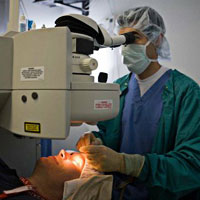MAP & LOCATION
Boothe Eye Care & Laser Center
3900 West 15th Street
Suite 104
Plano, Texas 75075
(214) 328-0444
Google Map
NEWS & UPDATES

Consumers agree, Boothe Eye Care & Laser Center is the best provider of Lasik and IntraLASIK in the Dallas Fort Worth area.
Nominate Dr. Boothe for 2009
 AcrySof Restor
AcrySof Restor
Experience a full range of vision without reading glasses or bifocals.
Learn More About Restor
 “Beyond LASIK”
“Beyond LASIK”
Read Newsweek’s web exclusive on the latest technologies available
for vision correction.
Click For More
Eye color often is the genetic trait that fascinates parents the most as a child develops. Will the child's eyes be black, brown, blue, gray, green, hazel or some combination of colors?
How a child looks depends on the genetic material each parent contributes to the child. But the parents' genes can mix and match in many different ways. The influences from each parent aren't known until — surprise — after the child is born!
How Eye Color Develops
The colored part of the eye is called the iris, which has pigmentation that determines our eye color.
Human eye color originates with three genes, two of which are well understood. These genes account for the most common colors — brown, blue and green. Other colors, such as gray, hazel and multiple combinations are not fully understood or explainable at this time.
We used to think of brown being "dominant" and blue being "recessive." But modern science has shown that eye color is not at all that simple. Also, eye colors don't come out as a blend of the parents' colors, as in mixing paint. Each parent has two pairs of genes on each chromosome. So multiple possibilities exist, depending on how the "Wheel of Fortune" spins.
Most babies are born with blue eyes that can darken in their first three years. Darkening occurs if melanin, a brown pigment usually not present at birth, develops with age. Children can have completely different eye colors than either of their parents. But if both parents have brown eyes, it's most likely that their children also will have brown eyes.
The darker colors tend to dominate, so brown tends to win out over green, and green tends to win out over blue. However, a brown/blue parent mix doesn't automatically produce a brown-eyed child.
Some children are born with irises that don't match in color. This is usually caused by faulty developmental pigment transport, local trauma either in the womb or shortly after birth or a benign genetic disorder. Other causes can be inflammation, freckle (diffuse nevus) of the iris and Horner's syndrome. Having an early eye exam is important to make sure nothing serious is going on — and "nothing serious" is the most common finding.
Changes in Eye Color
The iris is a muscle that expands and contracts to control pupil size. The pupil enlarges in dimmer lighting and grows smaller in brighter lighting. The pupil also shrinks when you focus on near objects, such as a book you are reading.
When the pupil size changes, the pigments in the iris compress or spread apart, changing the eye color a bit. Certain emotions can change both the pupil size and the iris color. That's why some people say their eyes change colors when they're angry or loving.
Eye color also can change with age. This happens in 10 to 15 percent of the Caucasian population (people who generally have lighter eye colors). For instance, my once very brown eyes are now hazel, a combination of brown and green. However, some hazel eyes actually get darker with age.
Note that if your adult eye color changes pretty dramatically, or if one eye changes from brown to green or blue to brown (called heterochromia), it's important to see your eye doctor. Eye color changes can be a warning sign of certain diseases, such as Fuch's heterochromic iridocyclitis, Horner's syndrome or pigmentary glaucoma.
Ultimately, if you don't like the eye color you inherited, you can always change it with colored contact lenses. But remember, even colored contact lenses are a prescription medical device and must be prescribed and monitored by an eye doctor. Don't buy them over the Internet or get them from a friend without having an eye doctor's prescription!
LASIK Web Marketing Powered by Ceatus Media Group LLC
